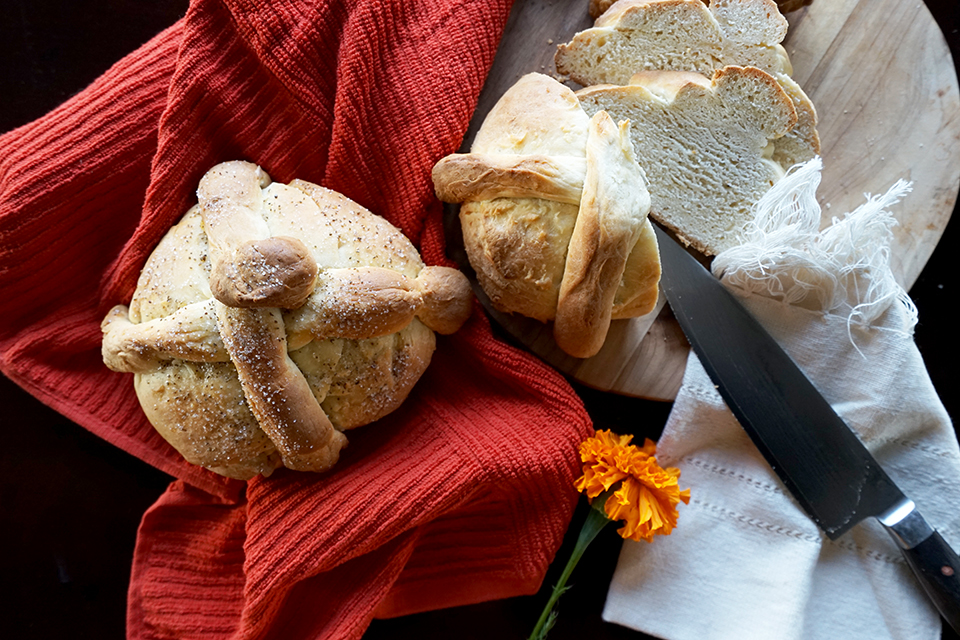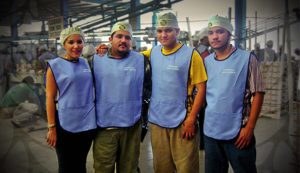Mango “Bread of the Dead” Pan de Muerto

“Pan de Muerto”, as it’s called in Spanish, is not only one of the significant elements placed at the altar during the Day of the Dead celebrations, it’s also generally eaten and enjoyed throughout the surrounding days as well as versions of it all year long. Although there are some graphic ancient stories which everyone seems to dispute that describe the original meaning, most today agree that the bread symbolizes the dead. Generally, its round shape signifies the body, as bones and skull adorn the top of the bread. There are varying recipes and ways of decorating them: seeds, sugar, and spices are just a few. It is a yeasted butter dough flavored with orange blossom and anise.
We use a version of our mango pit syrup flavored with orange. Orange blossom water is harder to get in the States, so this version is really lovely and mango-centric, it honors the departed loved ones of the Crespo family, including the patriarch Roberto Crespo Fitch.
SHARE THIS RECIPE
Mango “Bread of the Dead” Pan de Muerto

Ingredients
For the mango pit-orange syrup
2 mango pits
½ cup freshly squeezed orange juice
2 cups water
½ cup sugar
For the bread
¼ cup whole milk
1 stick (1/2 cup) salted butter, cubed small
2 teaspoons anise seed
1 tablespoon orange zest
½ cup Mango Pit Syrup, warm
2 ½ cups bread flour
1 ¼ teaspoons active dry yeast
1 teaspoon salt
¼ cup raw sugar
2 eggs, lightly beaten
For the glaze
½ cup Mango Pit Syrup
1 tablespoon melted butter
¼ cup mango purée
1/4 cup raw sugar
1 teaspoon anise seed

Method
For the mango pit-orange water
Place the mango pits, orange juice, sugar and water in a small sauce pan and bring to a boil. Reduce heat and simmer for about 12 minutes, stirring occasionally. Take off the heat and allow to cool completely.
For the bread
Heat the milk, butter, anise seed, orange zest and mango pit syrup in a medium saucepan until the butter is fully melted. Keep warm. In a large mixing bowl, combine 1 cup of the flour, together with the yeast, salt and sugar. Add the warmed milk mixture and the eggs, and mix until a smooth batter is formed. Add the remaining ½ cup of flour until a soft, slightly sticky dough is formed.
Toss a little flour down on a clean work surface and knead the dough for 8 minutes, until it is smooth and elastic, adding small amounts of flour as needed to avoid the dough sticking to your work surface.
Place the dough in a lightly greased bowl and cover with a kitchen towel. Let the dough rise in a warm place for about 2 hours – until it doubles in size.
Pre-heat oven to 350° F.
Punch the dough down and break it in half. Cut off a small handful of each half and set aside under a kitchen towel for your skull and crossbones. Shape each half of dough into a round loaf and place on a baking sheet lined with parchment paper.
Take each piece of the dough that’s left and divide it into three pieces. Shape the first one in a small ball shape. Shape the other two into long ropes, pressing your hands and fingers and rolling outwards. Place the ropes down crossing over the top of the loaf like an X. Place the round ball shape piece of dough on the top of the loaf, where the ropes meet.
Using your fingers, pinch the rope part in a few places so it makes an indentation, so that the rope has thicker and thinner widths, like bones. Do the same for the second loaf. Cover with a kitchen towel and let stand in a warm spot and re-rise for 45 minutes. Place in the oven and bake for about 30-40 minutes until the loaves are golden brown. Allow to cool slightly before glazing.
For the glaze
Mix together the syrup, butter and the purée. Brush the warm loaves generously with the glaze and then immediately sprinkle some sugar and anise seed on top.












